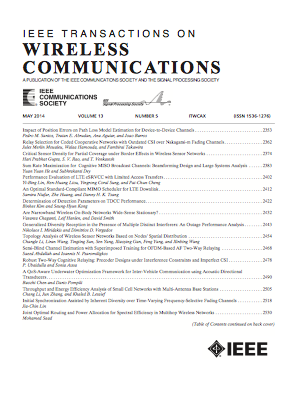全息MIMO通信中信道矩阵的电磁归一化
IF 10.7
1区 计算机科学
Q1 ENGINEERING, ELECTRICAL & ELECTRONIC
引用次数: 0
摘要
全息多输入多输出(MIMO)通信引入了创新的天线阵列配置,例如密集阵列和体积阵列,与具有半波长元件间距的传统平面阵列相比具有显着优势。然而,准确评估这些新型全息MIMO系统的性能需要仔细考虑信道矩阵归一化,因为它受阵列增益的影响,而阵列增益又取决于阵列拓扑。传统的规范化方法可能不足以评估这些先进的阵列拓扑,可能导致误导或不准确的评估。在这项研究中,我们提出了适应任意阵列拓扑的通道矩阵的电磁归一化方法,利用了分析、物理和全波方法的阵列增益。此外,我们还介绍了一种基于严格的二进格林函数方法的近场MIMO信道归一化方法,该方法考虑了近场增益的潜在损失。最后,通过采用所提出的归一化技术,我们在准静态、遍历和近场条件下进行了容量分析。我们的研究结果表明,信道矩阵归一化应该反映天线阵列沿目标方向的实现增益。在评估非常规全息阵列拓扑的性能限制和优势时,如果不能准确地归一化信道矩阵,可能会导致错误,从而可能影响全息MIMO系统的优化设计。本文章由计算机程序翻译,如有差异,请以英文原文为准。
Electromagnetic Normalization of Channel Matrix for Holographic MIMO Communications
Holographic multiple-input and multiple-output (MIMO) communications introduce innovative antenna array configurations, such as dense and volumetric arrays, which offer notable advantages over conventional planar arrays with half-wavelength element spacing. However, accurately assessing the performance of these new holographic MIMO systems necessitates careful consideration of channel matrix normalization, as it is influenced by array gain, which, in turn, depends on the array topology. Traditional normalization methods may be insufficient for assessing these advanced array topologies, potentially resulting in misleading or inaccurate evaluations. In this study, we propose electromagnetic normalization approaches for the channel matrix that accommodate arbitrary array topologies, drawing on the array gains from analytical, physical, and full-wave methods. Additionally, we introduce a normalization method for near-field MIMO channels based on a rigorous dyadic Green’s function approach, which accounts for potential losses of gain at near field. Finally, we perform capacity analyses under quasi-static, ergodic, and near-field conditions, through adopting the proposed normalization techniques. Our findings indicate that channel matrix normalization should reflect the realized gains of the antenna array along target directions. Failing to accurately normalize the channel matrix can result in errors when evaluating the performance limits and benefits of unconventional holographic array topologies, potentially compromising the optimal design of holographic MIMO systems.
求助全文
通过发布文献求助,成功后即可免费获取论文全文。
去求助
来源期刊
CiteScore
18.60
自引率
10.60%
发文量
708
审稿时长
5.6 months
期刊介绍:
The IEEE Transactions on Wireless Communications is a prestigious publication that showcases cutting-edge advancements in wireless communications. It welcomes both theoretical and practical contributions in various areas. The scope of the Transactions encompasses a wide range of topics, including modulation and coding, detection and estimation, propagation and channel characterization, and diversity techniques. The journal also emphasizes the physical and link layer communication aspects of network architectures and protocols.
The journal is open to papers on specific topics or non-traditional topics related to specific application areas. This includes simulation tools and methodologies, orthogonal frequency division multiplexing, MIMO systems, and wireless over optical technologies.
Overall, the IEEE Transactions on Wireless Communications serves as a platform for high-quality manuscripts that push the boundaries of wireless communications and contribute to advancements in the field.

 求助内容:
求助内容: 应助结果提醒方式:
应助结果提醒方式:


